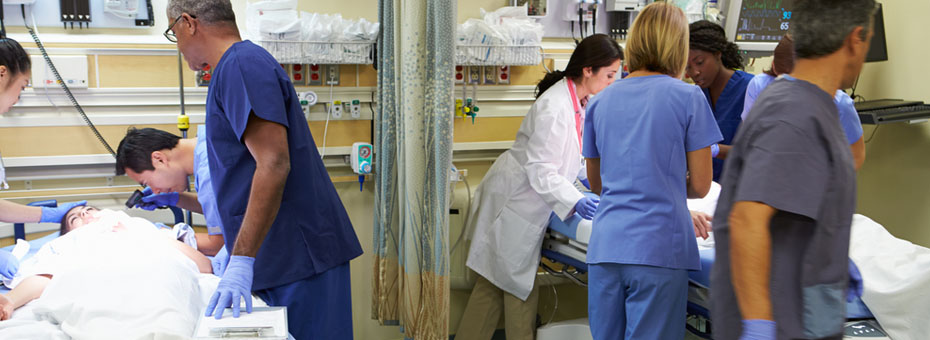I’ve been thinking a lot about how to improve patient care, in my own organization and in healthcare in general. How can we give patients better care, faster (when they need it most)?
Leveling the workload has been described as the foundation of the Toyota Production System. Much of my career has been dedicated to understanding how to apply leveling to dentistry. And the more I think about leveling in dentistry, the more I think about how it might help congestion in hospital emergency departments.
In Kanban: Just-In-Time at Toyota, Taiichi Ohno wrote: “What we have accomplished was to equalize the amount of work by ‘leveling’ the peak. What five people could not handle before is now done by two or three.”
By leveling the workload Ohno produced the same output with fewer people. In healthcare, however, leveling is not as simple as in manufacturing where you can produce a car in one location and sell it in another. The healthcare consumer (patient) has to be present when we perform the service (treatment).
In a normal day in my dental practice, we level our schedule to match our staff capacity, without exceeding the patient’s tolerance for delivery time. In emergencies, however, we need to deliver care faster, which causes unevenness in the workload — Mura. We know the antidote to Mura is flexibility in the delivery system.
To create flexibility, we spread the workload among staff and over time. So for us in dentistry (as it would be in any healthcare profession), workload leveling is internal; it deals with employees and with equalizing work distribution among employees. In manufacturing and other non-healthcare services leveled production deals with output—finished products received by external consumers.
What personnel are we talking about? Do we mean spread the assisting work among assistants, front desk work among front desk personnel, and hygiene work among hygienists? Certainly not. That would be siloed thinking. What we’ve done is spread the workload across every person in the office, within the limits of laws and regulations.
How have we achieved this? First, we cross-trained everyone. Second, we made sure people were willing to cross functional barriers. We made this optional at first; any front desk assistant, for example, had the right to refuse helping chair side because that was not in his/her job description. Over time, as people left, we included that flexibility requirement in the job description. Today, every employee moves between departments. Third, we standardized work in the each area to limit training requirements.
And finally, we created the position of Patient Care Flow Manager (“Flow Manager” for short) who redirects other staff members throughout the day to where they are needed most. She uses a paper kanban to fine tune the operation of matching capacity to demand. It’s common practice today to see assistants helping out by answering phone calls when the front desk is busy, or vice versa. What ten people could not handle before is now done by six, and everyone is less stressed.
Can we extrapolate to hospitals?
In an interview with Chet Marchwinski, “Reflections on 25 Years of Lean,” Dan Jones has said, “Hospitals have two flows, the emergency flow and the planned flow—the elective procedures and so on. And they go through very common steps that were not recognized before as common steps. And the criticality of providing the right test results, the right support, the right therapies, the right drugs at the right time, at the right place, that was not there before and now it’s been raised to the surface.”
Dan’s comment about only “two flows” in a hospital is a revelation that, to me, seems fundamental to healthcare improvement. In today’s hospitals, the two flows belong to two different departments, with more complaints about congestion in the ED. Hospitals keep trying to resolve the problem with different degrees of success.
Suggestion: Merge two work flows by leveling the workload
Mark Graban, a lean coach who has worked with many healthcare organizations, has written: “Are we taking advantage of opportunities to level load workloads or processes where we can… or at least better match staffing to demand in areas where demand is not shapeable (like emergency departments)?” It’s an important question!
To match staffing to demand, hospitals might consider redeploying staff from other parts of the hospital. Our positive experience with leveling, with workload reduction, cross training, and a flexible workforce, suggests that the solution in emergency department (or any other department) congestion might be found outside the bounds of the department. Lean teaches us that we find effective countermeasures to problems when we think across the organization.
Resources, especially personnel, should be able to move between the hospital and the emergency department as needed. The load should be shared by the whole hospital. Leveling may work differently in healthcare than in manufacturing, but it doesn’t mean it’s not possible. To do it, cross-training between the emergency department and the rest of the hospital would be a requirement. Another requirement would be to standardize processes between floors and departments in order to minimize training needs and facilitate personnel transfer.
After reading Dan Jones’s work and running my own experiments in dentistry, most with great success for our organization, I’m curious as to which hospitals and healthcare organizations would consider this new way of working. Which healthcare organizations are already practicing this way?





